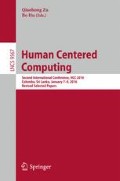Abstract
For the parasite eggs recognition method based on image has disadvantage in real-time and accuracy, this paper presents a shape recognition method combined with gray scale and colorimeter distribution features, and designs a recognition system of human parasite eggs based on MapReduce which takes advantage of the thought about parallel framework of MapReduce. Experiments show that the implementation of the recognition system has good accuracy and real-time.
Access this chapter
Tax calculation will be finalised at checkout
Purchases are for personal use only
References
Bruun, J.M., Kapel, C.M.O., Carstensen, J.M.: Detection and classification of parasite eggs for use in helminthic therapy. In: IEEE International Symposium on Biomedical Imaging. pp. 1627−1630. IEEE, January 2012
Sommer, C.: Digital image analysis and identification of eggs from bovine parasitic nematodes. J. Helminthol. 70(2), 143–151 (1996)
Sommer, C.: Quantitative characterization of texture used for identification of eggs of bovine parasitic nematodes. J. Helminthol. 72(2), 179–182 (1998)
ZYang Y.S., Park, D.K., Kim, H.C., et al.: Automatic identification of human helminth eggs on microscopic fecal specimens using digital image processing and an artificial neural network. IEEE Trans. Biomed. Eng. 48(6), 718−730 (2001)
Zhao, Y.-E.: Automatic identification of human parasite eggs. China Stereology Image Anal. 2(3), 135–138 (1997)
Peng, S.-X., Liao, S.-T.: Study on computer automatic recognition technology of parasite eggs. J. Hunan Normal Univ. (Medical Edition) 2(2), 11–15 (2005)
Li, F., Sun, Q.-Y.: Study on the shape classification algorithm of human parasite eggs based on the features of image boundary. Comput. Sci. 39(5), 261–265 (2011)
Li, J.-J., Cui, J., et al.: Survey of mapreduce parallel programming model. Acta Electronica Sinica 39(11), 2635–2642 (2011)
Author information
Authors and Affiliations
Corresponding author
Editor information
Editors and Affiliations
Rights and permissions
Copyright information
© 2016 Springer International Publishing Switzerland
About this paper
Cite this paper
Li, F., Hu, X. (2016). Research and Design on the Recognition System of Human Parasite Eggs Based on MapReduce. In: Zu, Q., Hu, B. (eds) Human Centered Computing. HCC 2016. Lecture Notes in Computer Science(), vol 9567. Springer, Cham. https://doi.org/10.1007/978-3-319-31854-7_21
Download citation
DOI: https://doi.org/10.1007/978-3-319-31854-7_21
Published:
Publisher Name: Springer, Cham
Print ISBN: 978-3-319-31853-0
Online ISBN: 978-3-319-31854-7
eBook Packages: Computer ScienceComputer Science (R0)

